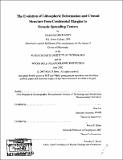| dc.contributor.advisor | Jian Lin and Maria T. Zuber. | en_US |
| dc.contributor.author | Behn, Mark Dietrich, 1974- | en_US |
| dc.contributor.other | Woods Hole Oceanographic Institution. | en_US |
| dc.date.accessioned | 2005-09-27T20:22:04Z | |
| dc.date.available | 2005-09-27T20:22:04Z | |
| dc.date.copyright | 2002 | en_US |
| dc.date.issued | 2002 | en_US |
| dc.identifier.uri | http://hdl.handle.net/1721.1/29061 | |
| dc.description | Thesis (Ph. D.)--Joint Program in Oceanography (Massachusetts Institute of Technology, Dept. of Earth, Atmospheric, and Planetary Science; and the Woods Hole Oceanographic Institution), 2002. | en_US |
| dc.description | Includes bibliographical references (p. 221-243). | en_US |
| dc.description.abstract | This thesis investigates the evolution of lithospheric deformation and crustal structure from continental margins to mid-ocean ridges. The first part (Ch. 2) examines the style of segmentation along the U.S. East Coast Margin and investigates the relationship between incipient margin structure and segmentation at the modem Mid-Atlantic Ridge. The second part (Chs. 3-5) focuses on the mechanics of faulting in extending lithosphere. In Ch. 3, I show that the incorporation of a strain-rate softening rheology in continuum models results in localized zones of high strain rate that are not imposed a priori and develop in response to the rheology and boundary conditions. I then use this approach to quantify the effects of thermal state, crustal thickness, and crustal rheology on the predicted style of extension deformation. The mechanics of fault initiation and propagation along mid-ocean ridge segments is investigated in Ch. 4. Two modes of fault development are identified: Mode C faults that initiate near the center of a segment and Mode E faults that initiate at the segment ends. Numerical results from Ch. 5 predict that over time scales longer than a typical earthquake cycle transform faults behave as zones of significant weakness. | en_US |
| dc.description.abstract | (cont.) Furthermore, these models indicate that Mode E faults formed at the inside-corner of a ridge-transform intersection will experience preferential growth relative to faults formed at the conjugate outside-corner due to their proximity to the weak transform zone. Finally, the last part of this thesis (Ch. 6) presents a new method to quantify the relationship between the seismic velocity and composition of igneous rocks. A direct relationship is derived to relate Vp to major element composition and typical velocity-depth profiles are used to calculate compositional bounds for the lower continental, margin, and oceanic crust. | en_US |
| dc.description.statementofresponsibility | by Mark Dietrich Behn. | en_US |
| dc.format.extent | 243 p. | en_US |
| dc.format.extent | 21442243 bytes | |
| dc.format.extent | 21441999 bytes | |
| dc.format.mimetype | application/pdf | |
| dc.format.mimetype | application/pdf | |
| dc.language.iso | eng | en_US |
| dc.publisher | Massachusetts Institute of Technology | en_US |
| dc.rights | M.I.T. theses are protected by copyright. They may be viewed from this source for any purpose, but reproduction or distribution in any format is prohibited without written permission. See provided URL for inquiries about permission. | en_US |
| dc.rights.uri | http://dspace.mit.edu/handle/1721.1/7582 | |
| dc.subject | Joint Program in Oceanography. | en_US |
| dc.subject | Earth, Atmospheric, and Planetary Sciences. | en_US |
| dc.subject | Woods Hole Oceanographic Institution. | en_US |
| dc.title | The evolution of lithospheric deformation and crustal structure from continental margins to oceanic spreading centers | en_US |
| dc.type | Thesis | en_US |
| dc.description.degree | Ph.D. | en_US |
| dc.contributor.department | Joint Program in Oceanography | en_US |
| dc.contributor.department | Woods Hole Oceanographic Institution | en_US |
| dc.contributor.department | Massachusetts Institute of Technology. Department of Ocean Engineering | |
| dc.identifier.oclc | 51035989 | en_US |
